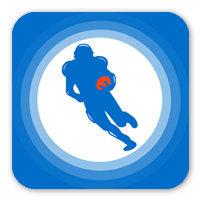Fantasy football lineup targets and sleepers for Week 1 of 2024. Josh looks at high-powered offenses to target, and the top fantasy lineup picks from each.
Hello, RotoBallers, and welcome to the inaugural High-Powered Offenses column. This article will identify offenses that are set up for a huge week and which players among them are great targets. The teams and players highlighted will change weekly based on the data trends, their current matchup, situational factors, and key injuries.
The foundation for determining which offenses to target will be based on a data-driven methodology focused on NFL scoring. You can find more details on that in the methodology section. On top of the number of points scored, we’ll also be incorporating player-level information within the offense and analyzing the opposing defense to generate a list of the players you want to rely on each week. A shoutout to Stathead and DraftKings for the information required to write this article. Also, it’s important to note that all the data for Week 1 will be based on the 2023-2024 season, given that we don’t have any current data for this year yet.
Below, you’ll find a sneak peek of the offenses to target, a breakdown of the methodology, a snapshot of each metric in a data table, a few key takeaways, and the list of offenses and players to target in Week 1. Let’s dig in!
Be sure to check all of our fantasy football rankings for 2025:- 2025 fantasy football rankings
- Running back (RB) rankings
- Wide receiver (WR) rankings
- Quarterback (QB) rankings
- Tight end (TE) rankings
- Defense (D/ST) rankings
- Kicker (K) rankings
- FLEX rankings
- Dynasty rankings
Week 1 Offenses to Target
- Detroit Lions
- Buffalo Bills
- Los Angeles Rams
- Houston Texans
- Cincinnati Bengals
Methodology
In terms of how it works, each week we’ll analyze four different metrics and their impact on the average number of points teams scored, including location (home, away), pace - offensive plays per game (above average, average, below average), offensive touchdowns per game (above average, average, below average), and offensive yards per game (above average, average, below average).
We’ll calculate the average number of points scored for all 11 categories, identifying trends and patterns that can provide further insight into scoring output. We’ll track the cumulative average points scored as the season progresses, creating a larger sample size with more accurate data.
Below, you’ll find a breakdown of each of the four metrics, explaining what they are and how the subcategories were created.
Metric #1 - Location
NFL teams travel across the country and abroad, battling one another every year. However, every team is allotted eight home games one year and nine the next, playing their remaining games on the road.
This metric is divided into two categories: home and road. Occasionally, teams play on a neutral side outside America, including England, Mexico, Brazil, and Germany. In those situations, whoever the NFL identifies as the host team will be considered the home team, while the visiting team will be viewed as the road team.
The expectation is that the home team will have the advantage and score more points because they do not need to travel and have the comfort of their normal amenities and routine, along with the familiarity of their stadium and the crowd support.
Metric #2 - Pace (Offensive Plays Per Game)
The pace of play represents how fast a team runs its offense. It’s a statistic that can be measured in several ways, but for this article, we will focus on the number of offensive plays per game a team runs, which includes passing attempts, rushing attempts, and sacks taken.
This metric is divided into three categories: above average, average, and below average. To find the average, we went back three seasons, including 2023, 2022, and 2021, to find the average number of plays for all 32 teams each year, creating a total of 96 team seasons. The average number of plays from that sample is 63.14.
We then expanded that number to create a range of 61 to 65 offensive plays per game, which we defined as the range for “average.” Thus, anything greater than 65.0 would be “above average,” and anything less than 61.0 would be “below average.”
Every week, each team's average offensive plays per game will be placed in one of the three ranges to identify the average points per game in that range for NFL teams that week.
Their plays per game will be recalculated based on their cumulative total for the season each week to provide a cumulative average number of points scored for the three categories. The further into the season we get, the more accurate this will be because the sample size will be larger.
Sometimes a team has a large lead and is attempting to run out the clock causing them to play slower, but in general, the expectation is that teams who run more offensive plays will have more scoring opportunities and thus score more points.
Metric #3 - Offensive Touchdowns Per Game
Touchdowns are one of the statistics with the highest variance at a player level, team level, and throughout a season for a particular franchise. However, as a league, the number is very consistent, especially when focusing on offensive touchdowns, which include passing and rushing.
This would exclude any touchdowns scored by a team’s defense or during special teams plays, such as kicking and punting. We've excluded these scoring plays because they are harder to predict and occur less frequently than offensive touchdowns.
This metric is also divided into three categories: above average, average, and below average.
To find the average, we went back three seasons, including 2023 where teams scored an average of 2.3 touchdowns per game, 2022 where teams scored an average of 2.3 touchdowns per game, and 2021 where teams scored an average of 2.4 touchdowns per game. We then took the average of those three seasons, which was 2.3.
Finally, we expanded that number to create a range of 2.2 to 2.4, which we defined as the “average.” Anything greater than 2.4 is defined as “above average,” and less than 2.2 would be “below average.”
Every week, each team's offensive touchdowns per game will be placed in one of the three ranges to identify the average points per game in that range for NFL teams that week.
Their offensive touchdowns per game will be recalculated based on their cumulative total for the season each week to provide a cumulative average number of points scored for the three categories. The further into the season we get, the more accurate this will be because the sample size will be larger.
The expectation is that teams who score more offensive touchdowns will score more points. We’ll be particularly curious about the gap in points scored between the three subcategories, not just a higher number.
Metric #4 - Offensive Yards Per Game
In addition to touchdowns, yards are another key measurement of offensive output. Because the range of numbers for yards is much wider, this statistic is more consistent among players and teams than touchdowns. Fortunately, it's consistent for the NFL as a whole as well. Similar to touchdowns, we’ll be incorporating only offensive output for the same reasons outlined above.
Once again, this metric is divided into three categories: above average, average, and below average.
As with the previous two metrics, we went back three seasons, including 2023, where teams scored an average of 331.6 yards per game, 2022 where teams scored an average of 340.1 yards per game; and 2021, where teams scored an average of 333.6 yards per game. We then took the average of those three seasons, which is 335.1.
Finally, we expanded that number to create a range of 320 to 350, which we defined as the “average,” with anything greater than 350 defined as “above average,” and less than 320 would be “below average.”
Every week each team's offensive yards per game will be used to place them in one of the three ranges to identify the average points per game in that range for NFL teams on that week.
Their offensive yards per game will be recalculated based on their cumulative total for the season each week to provide a cumulative average number of points scored for the three categories. The further into the season we get, the more accurate this will be because the sample size will be larger.
Sometimes, a team will begin a drive with a great field position because of their defense or special teams unit, which decreases the number of yards required to score a touchdown or kick a field goal. But, in general, the expectation is that teams who produce more yards on offense will score more points.
Additional Measures
These four metrics above will set the foundation for identifying offenses to targets based on the different thresholds.
We’ll incorporate additional inputs such as the team’s record (wins, losses, and ties), which teams are favored to win by the betting market, metrics like pre-snap motion rate and pass rate over expectation, and changes in personnel or coaching staff to help hone in on the high-powered offenses to target.
We’ll also go beyond the offensive perspective to factor in the opposing defense and other variables that could impact the offensive output, such as weather.
Data Tables
Data Table #1 - Location
| Location | Average Points Scored |
| Home | 23.16 |
| Road | 20.36 |
Data Table #2 - Pace (Offensive Plays Per Game)
| Offensive Plays Per Game | Average Points Scored |
| Above Average (above 65.0) | 23.86 |
| Average (61.0-65.0) | 21.45 |
| Below Average (under 61.0) | 19.60 |
Data Table #3 - Offensive Touchdowns Per Game
| Offensive Touchdowns Per Game | Average Points Scored |
| Above Average (over 2.4) | 27.81 |
| Average (2.2-2.4) | 21.60 |
| Below Average (under 2.2) | 18.21 |
Data Table #4 - Offensive Yards Per Game
| Offensive Yards Per Game | Average Points Scored |
| Above Average (over 350) | 26.37 |
| Average (320-250) | 22.03 |
| Below Average (under 320) | 18.09 |
Data Takeaways
Having a full 17-game sample for all 32 teams is ideal from a data perspective. While there will be fluctuation from year to year, it illustrates the value of each of the four metrics, highlighting where the largest gaps were in 2023. Based on that, here are a few key takeaways:
The largest gap between subcategories within a metric was the drop from the “above average” to the “average” group in the offensive touchdowns per game metric, which was 5.79 points per game. It makes sense that offensive touchdowns and points scored would be most strongly correlated, given that touchdowns result in points.
However, the gap of about a touchdown worth of points justifies the emphasis on targeting players on teams that find the end zone at a higher rate.
The lowest number of points scored in any subcategory came from teams that failed to hit 320 offensive yards, averaging just 18.09 points per game. When you examine the data further, you'll find that 11 teams finished with fewer than 320, including seven that didn’t even average 300 in 2023.
If you isolate only those seven teams, which include Denver, Las Vegas, Tennessee, New York (Giants), New England, New York (Jets), and Carolina, you'll get an average of 16.81 PPG. Unsurprisingly, you'd be hard-pressed to find more than a handful of players who were difference-makers in fantasy last season from those seven franchises.
Lastly, there was about a three-point gap between home and away teams throughout the season. It's comparable to the spread the betting market typically assigns to a matchup where the two teams playing one another are evenly matched.
When you go week by week through the season, the only time the road teams outscored the home teams was in Week 1 and Week 2. Home teams outproduced the road teams every other week, making the location an important factor to consider.
Week 1 Offenses & Players To Target
Offense No. 1 - Detroit Lions
It's probably not a surprise to see the Lions here, given that they're projected to be one of the NFL's best offenses, but sometimes it's worth taking the layup. Detroit averaged the fifth-most points per game last season at 27.12.
They also cleared all three thresholds for the metrics above, including 394.82 yards per game (third-best), 3.35 touchdowns per game (tied for second-best), and the second-most offensive plays per game at 66.88.
On top of all that, they're at home where we know they perform better, checking all four boxes above. Lastly, they host the Rams in a rematch of the quarterback-swap bowl from the playoffs, where the Lions hung on to win 24-23.
The obvious: Regardless of the week, players like Amon-Ra St. Brown, Sam LaPorta, and Jahmyr Gibbs are in your lineup, so we won't spend more time on them.
Players to target:
Player No. 1 - Jared Goff: At home with a healthy supporting cast, Goff is money. His passer rating at Ford Field last season was 107.9, with 2.4 touchdowns per game and 280 yards per game.
Additionally, the one area he tends to struggle with is pressure in the pocket. While the Rams have made some improvements to their defense, the loss of Aaron Donald can't be understated when it comes to generating pressure. He's a top-12 starter with top-6 upside.
Player No. 2 - David Montgomery: With Gibbs expected to take a Year 2 leap and earn more work, Montogmery fell in drafts again this offseason, becoming a great value. If you elected to scoop him up as a potential RB2 or part of a zero-RB build, you can feel confident starting him in Week 1.
Los Angeles allowed the second-fewest fantasy points to running backs, but some of that has to be attributed to Donald, who we mentioned them losing to retirement above. Plus, Montgomery is a lock to see multiple rushing attempts near the goal line. He's a solid top-24 back.
Player No. 3 - Jameson Williams: It's unusual to get two years into a player's career and feel like the sample size is too small to draw any conclusions, but that's the case with Williams. He spent most of his rookie campaign injured, returning for just six contests. He was sparsely used but did flash big-play ability.
Things became more complicated when he received a four-game suspension for sports betting to begin his sophomore season. He remained a part-time player, clearing 60% of the offensive snaps twice.
He continued to showcase his explosiveness, averaging 14.75 yards per reception with two long touchdowns of 32 and 45 yards on 24 total catches. The team moved on from Josh Reynolds, opening the door for him to break out finally. Week 1 in a potential shootout at home is an ideal spot to take a shot.
Offense No. 2 - Buffalo Bills
The Bills are one of the most controversial offenses this year. We saw a seismic shift in philosophy after the new OC, Joe Brady, took over, emphasizing pounding the rock. The team also won six of their seven final outings after the change, which is the basis for the argument that the run-heavy trend will continue.
The other feather in the cap of that prediction would be the decision to trade Stefon Diggs and let Gabe Davis walk in free agency. They did draft Keon Coleman, but it's hardly a one-for-one replacement.
The truth is likely somewhere in the middle of the halves, but in totality, they averaged the sixth-most points per game last season at 26.53. They also cleared all three thresholds, including 374.47 yards per game (fourth-best), 3.00 touchdowns per game (fifth-best), and 65.59 offensive plays per game (fifth-most).
Add in a home matchup against the Cardinals, who project as one of the worst defenses this season, and this offense should start hot.
The obvious: Josh Allen, James Cook, and Dalton Kincaid probably fit into this category given where you drafted them. Allen is a perennial superstar, so there are no questions there, but entering this season, Cook and Kincaid should be heavily involved with minimal options remaining.
Players to target:
Player No. 1 - Khalil Shakir: One of the few talented pass-catchers behind Cook and Kincaid is Shakir, who became more involved down the stretch, playing 67% or more of the offensive snaps in their final four games, including the playoffs.
He found the end zone in both postseason appearances and went over 100 receiving yards in the regular season finale. Curtis Samuel is pushing to get on the field with a toe injury, while the rookie Coleman is still a raw prospect, creating an opportunity for Shakir to make his mark in Week 1.
Offense No. 3 - Los Angeles Rams
Injuries rocked the Rams starters for the first 10 weeks, but coming out of their bye, they had all hands on deck to make a playoff push. They averaged 29.28 points per game from weeks 11 through 17 with a 6-1 record. Furthermore, they averaged 395.29 offensive yards per game during that same timeframe.
Those marks would've ranked second in both categories for the 2023 season. It's clear that Sean McVay still has the magic touch. So, with exceptional personnel and a healthy squad, they'll remain a dangerous offense.
As referenced above, they'll travel to Detroit in a potential barn burner with a 51-point over/under, tied for the highest on the week, making them an ideal pick to produce out of the gate.
The obvious: It's been far from smooth sailing this offseason for Kyren Williams, Puka Nacua, and Cooper Kupp, but drafters seem comfortable with all three as top picks, especially the first two, both of whom dealt with injuries during training camp or the preseason. You may have an abundance of wideouts that make Kupp expendable for Week 1, but he's most likely locked in.
Players to target:
Player No. 1 - Matthew Stafford: Attacking the Lions on the ground is difficult, encouraging opponents to air it out. They gave up the third-most yards per pass attempt at 7.4 and finished dead-last in yards per completion allowed at 11.6.
It's worth noting that they made some additions to their secondary, but it's hard to imagine them going from the bottom of the pack to a top-half pass defense. Similar to Goff, Stafford is a top-12 signal-caller with elite touchdown upside.
Player No. 2 - Demarcus Robinson: Tutu Atwell was making waves early in the year, but when the Rams were firing on all cylinders, it was Robinson that they relied on as their WR3.
He scored a touchdown in four straight outings from Weeks 12 through 15 and cleared 50 receiving yards in three of five contests from Weeks 11 through 16. Despite some offseason hype about Jordan Whittington, he secured the No. 3 role, making him a perfect flex option.
Offense No. 4 - Houston Texans
Sometimes, the first-to-worst sentiment in the NFL gets overstated, but the Texans met that definition to a tee. Selecting C.J. Stroud with the No. 2 overall pick to pair with first-time head coach Demeco Ryans was a match made in heaven. They dethroned the Jaguars to earn a division crown, won a playoff game, and cemented themselves as a team to take seriously in 2024.
They finished 13th in points per game with 22.18, cleared the offensive plays per game threshold with 65.53, and nearly met the other two with 339.53 offensive yards per game and 2.29 offensive touchdowns per game.
Moreover, instead of resting on their laurels, they upgraded their backfield and bolstered their receiving corps by acquiring Joe Mixon from the Bengals and Stefon Diggs from the Bills, adding two proven veterans with winning pedigrees that should propel this offense even further.
Opening the season on the road against the Colts, who play fast with a susceptible defense, sets up well for Houston in the matchup tied for the third-highest over/under at 48.5.
The obvious: A lot of the offseason was spent deciphering which of these three is the No. 1 wideout and who will play in two-receiver sets, but Nico Collins, Tank Dell, and Diggs are talented pass-catchers that figure to crack your lineup most weeks, even if the production is inconsistent at times.
Throwing those three the ball is the aforementioned Stroud, who skyrocketed in drafts as the QB5. While it's reasonable to question taking him anywhere near the top five, he's a lock to start if you drafted him.
Players to target:
Player No. 1 - Joe Mixon: The fifth member of this quintet is Mixon, who profiles as a tailback with a high floor and moderate ceiling. There are some warning signs in terms of efficiency and age. However, to begin the season, he's in the top 20 against Indy, who allowed the fifth-most fantasy points to RBs.
Player No. 2 - Dalton Schultz: The crowded receiving room is bad news for Schultz. However, the team signed him to a new deal after relying on him at times last season. He's no longer a plug-and-play type option, but as part of a potent ascending offense, he's a solid streamer.
Offense No. 5 - Cincinnati Bengals
Speaking of Mixon, the Bengals are the final offense to spotlight this week. Evaluating their season in its entirety is unfair because Joe Burrow strained his calf during training camp, which lingered into the regular season, and then tore his wrist in Week 11, ending his 2023 campaign.
Tee Higgins also dealt with injuries as he often does. Even with Jake Browning at the helm, this offense remained functional.
From Weeks 5 through 9, which was once Burrow was healthy, and before he got hurt, Cincinnati averaged 26.6 points per game with a 4-1 record. They also averaged 354.2 offensive yards per game and 3.0 offensive touchdowns.
It's a small sample, but it aligns with what we've seen from this team in 2022. They also begin the year at home against the Patriots, who are favored to finish as the worst team in the league.
The obvious: Ja'Marr Chase and Higgins form one of the best duos in the NFL. The latter dropped quite a bit in drafts this year, but that has more to do with injury history and reliability than talent. When he's healthy, he's productive.
UPDATE: Chase will play on a snap count while Higgins is out. Chase is still a good start, but more in the WR12-15 range.
Players to target:
Player No. 1 - Joe Burrow: Burrow, who was once a must-start, has faded into the low-end starter range, bordering on the streamers. He's one of the more underrated options and deserves to be in your lineup in Week 1.
UPDATE: Chase will play on a snap count while Higgins is out. It pushes Burrow into the streamer tier.
Player No. 2 - Zack Moss/Chase Brown: The void left by Mixon is large. The team signed Moss, who flashed as a fill-in for Jonathan Taylor in Indy, to pair with the sophomore Brown. From a talent perspective, it's clear Brown has more to offer, but he struggled to earn a role in his rookie season.
The team has spoken highly of him, particularly his ability to pass protect, which was a major concern, making him an intriguing flex option. Moss, on the other hand, should open as the starter and figures to be involved near the goal line, making him a decent bet for volume.
UPDATE: Chase will play on a snap count while Higgins is out. Both backs could receive more work.
Hopefully, you found this article helpful as you prepare for Week 1. Thanks for reading. We’ll be back next week with more offenses and players to target.
Download Our Free News & Alerts Mobile App
Like what you see? Download our updated fantasy football app for iPhone and Android with 24x7 player news, injury alerts, rankings, starts/sits & more. All free!

More Fantasy Football Analysis





 RADIO
RADIO
























